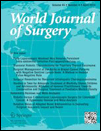Postoperative Skeletal Muscle Loss Predicts Poor Prognosis of Adenocarcinoma of Upper Stomach and Esophagogastric Junction
Electronic supplementary material: The online version of this article (https://doi.org/10.1007/s00268-018-4873-6) contains supplementary material, which is available to authorized users.
Abstract
Background
The relationship between postoperative changes in muscle mass and the prognosis of malignancies remains controversial. We aimed to determine whether a decrease in skeletal muscle mass after surgical resection can predict long-term outcomes in patients with adenocarcinoma of upper stomach (AUS) and esophagogastric junction (AEGJ).
Methods
We reviewed 146 patients who underwent curative surgery for AUS and AEGJ. We assessed the skeletal muscle index pre- and post-surgery and 6 months postoperatively. The rate of decrease in skeletal muscle index (SMI) was calculated and its relationship with clinicopathological factors and prognosis was analyzed.
Results
Among the 146 patients studied, 115 underwent re-assessment of SMI 6 months postoperatively. The mean decrease in SMI was more prominent in patients with recurrence than in those without recurrence (19.0 ± 2.3 vs. 7.4 ± 0.9%, respectively, P < 0.0001). AUS and AEGJ patients with a >19% decrease in SMI showed significantly lower 5-year overall survival and recurrence-free rates than those with a <19% decrease in SMI (recurrence-free survival: 33.4 vs. 89.2%, respectively, P < 0.0001; overall survival: 40.6 vs. 90.0%, respectively, P < 0.0001). Multivariate analyses indicated that a ≥19% decrease in SMI could predict poor overall survival independently in patients with AUS and AEGJ (P = 0.0070).
Conclusions
A ≥19% postoperative decrease in SMI was substantially associated with poor survival in patients with AUS and AEGJ.




